Article from the Weekend
Gardener Online Magazine
by Hilary Rinaldi, member of the National Garden Writers Association

Propagate
Your Favorite Plants
With Root Cuttings
Four simple steps to propagate
more trees, shrubs and perennials
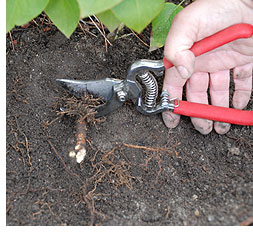 Taking root
cuttings is one of the most reliable and economical ways to produce
many perennial and woody plants.
It's also pathetically easy, so if you've ever
had problems propagating some of your favorite plants, this may be the
way for you to go.
It's best done during the plant's dormant
season usually between November and February, and is such a
straightforward process, you can do it in four steps. How's that for
easy?
At the end of the article we have listed many
plants that do well with root cuttings, but if you're careful, test
doing some plants that are not on the list and see how you do.
Just keep in mind that some plants like roses
and fruit trees are grafted, so if you take root cuttings you will be
propagating the root stock, and not the grafted variety that you enjoy
above the grafted root stock. Taking root
cuttings is one of the most reliable and economical ways to produce
many perennial and woody plants.
It's also pathetically easy, so if you've ever
had problems propagating some of your favorite plants, this may be the
way for you to go.
It's best done during the plant's dormant
season usually between November and February, and is such a
straightforward process, you can do it in four steps. How's that for
easy?
At the end of the article we have listed many
plants that do well with root cuttings, but if you're careful, test
doing some plants that are not on the list and see how you do.
Just keep in mind that some plants like roses
and fruit trees are grafted, so if you take root cuttings you will be
propagating the root stock, and not the grafted variety that you enjoy
above the grafted root stock.
Step 1
Carefully
Uncover The Roots
The best time to
take root cuttings is when the plants are dormant which is usually
between November and February. At this time, there is a large amount of
stored energy in the roots, and there is less stress on the parent
plant because they are not actively growing and in as much need of
their root system.
For
Woody Plants
1.To take root cuttings from trees and shrubs, carefully remove dirt
around the roots on one side of the plant.
2. It's best to dig fairly close to the base of the plant to make sure
you find roots belonging to the plant you are working on.
3.
Take a close look at the roots that you want to take cuttings from and
make sure they're healthy, living roots, not dead ones that look black
or dried out.
4. Choose roots that are pencil thick.
For
Perennial Plants.
1. For perennials and smaller plants, it's usually easier to lift the
entire parent plant.
2. Look for large fleshy
roots, the thicker the better.
|
Carefully
Uncover The Roots
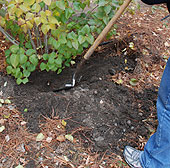
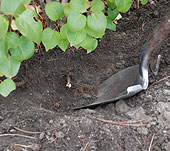 |
Step 2
Take Your Root Cuttings
For both woody plants and perennial plants, don't take more than
one-third of the roots off. This way you will leave enough roots for
the parent plant to recover.
For Woody Plants
1. Now that you have found healthy, pencil thick roots, take 2 to 6
inch (2 to 15 cm) cuttings and then cut into 2 to 3 inch (6 to 7.5 cm)
sections.
2. Important Tip: Keep track of which side of the root is the "up"
portion of the root and which is the "down" portion! The "up" portion
is the part closest to the parent plant, and the "down" portion is the
part farthest down in the soil. This is important since they won't root
upside down.
3. The best way to keep track of "up" and "down" is to make a flat cut
on top or "up" side, and a slanted cut on "down" or bottom side.
4. Cover the roots back up again and water the plant in.
For Perennial Plants
1. For plants with smaller roots, like perennials, take 2 to 3 inch (5
to 7.5 cm) cuttings the same way as above with a flat cut on top and a
slanted cut on the bottom to help you remember the root's correct
orientation.
2. Because with smaller plants we have lifted the entire plant out,
after you have taken your cuttings, then replant the parent plant.
3. Water the plants to settle the roots back into the soil properly.
|
Take Your Root Cuttings
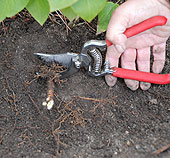
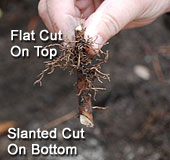
|
Step 3
Plant Your Root Cuttings
1. Use a deep pot, raised planter bed, or just in the soil somewhere to
plant your root cuttings - as long as they are in a in a frost-free
area.
2. Before you plant them, put a little bit of sand in the bottom of the
hole and dust the bottom of each cutting with powdered sulfur to
control fungi. This helps keeps the roots from rotting.
3. Plant in moist potting soil a few inches apart, and make sure that
the tops of the cuttings are about 1 inch (2.5 cm) below the soil
surface.
4. Cover with 1/4 to 1/2 inch (cm) of coarse sand or small gravel.
5. Water only when soil becomes dry and try not to keep the soil too
wet because the roots can rot. |
Dip Bottom Ends In Sulfur
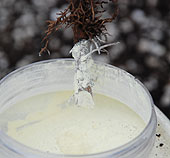
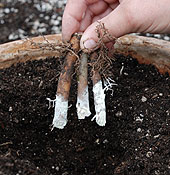
Plant 1 inch (2.5 cm)
Below Soil Surface
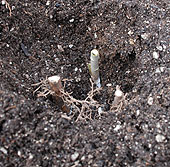
Cover With Coarse Sand
or Small Gravel
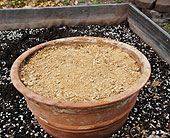
|
Step 4
When Shoots Appear, Plant Them Out
1. In three to four weeks your cuttings should be forming roots, and
some even may start to push new growth.
2. When new shoots appear, give them some liquid fertilizer at half
strength.
3. Once the plants are established, they can be transplanted to
individual pots or moved into the garden.
4. When planting out the cuttings, make sure the tops of the cuttings
(the straight cut ends) are about 2 inches (5 cm) below the soil
surface.
5. Keep in mind, perennial root cuttings can start pushing new growth
fairly quickly, so you might need to protect them from any freezing
weather.
|
New Shoots,
Plant Them Out
 |
List of Plants For Root Cuttings:
Woody Plants
Angel's Trumpet (Brugmansia)
Crabapple (Malus)
Crape Myrtle (Lagerstroemia)
Figs (Ficus carica)
Glory bowers (Clerodendrum)
Hydrangeas (Hydrangea spp.)
Japanese Aralia (Fatsia)
Lilacs (Syringa vulgaris)
Mock oranges (Philadelphus coronarius)
Oregon grapehollies (Mahonia aquifolium)
Popler (Populus)
Pussy willow (Salix discolor)
Raspberry and Blackberry (Rubus spp.)
Red and yellow twig dogwoods (Cornus stolonifera)
Rose of Sharons (Hibiscus syriacus)
Roses, nongrafted types (Rosa spp.)
Snowball bush (Viburnum)
St.John's-wort (Hypericum)
Sumac (Rhus typhina)
Trumpet vine (Campsis radicans)
Weeping willow (Salix babylonica)
Wisteria
Yucca
Perennial Plants
Aster
Anchusia Italica (Related to Forget-me-not)
Barrenworts (Epimedium spp.)
Bear’s breeches (Acanthus mollis)
Bellflower (Campanula)
Blanket Flower (Gaillardia)
Blue stars (Amsonia spp.)
Cardoon (Cynara cardunculus)
Colewort (Crambe cordifolia)
Comfreys (Symphytum spp.)
Cranesbill (Erodium)
Epimediums (all do well)
False sunflower (Heliopsis helianthoides)
Garden phloxes (Phlox paniculata)
Gernaium (Gernaium spp.)
Globe Thistle (Echniops)
Hollyhocks (Alcea rosea)
Horseradish (Brassicaceae)
Japanese anemones (Anemone X hybrida)
Japanese aster (Kalimeris pinnatifida)
Joe Pye weed (Eupatorium fistulosum)
Matilija poppy (Romneya)
Oriental poppies (Papaver orientale)
Pasque flowers (Pulsatilla spp.)
Primrose (Primula)
Rhubarb
Sage (Salvia spp.)
Sea hollies (Eryngium planum)
Sea Kale (Crambe maritima)
Statice (Limonium spp.)
Yarrow (Achillea)
|
Glory Bower
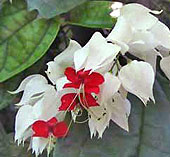
Lilac
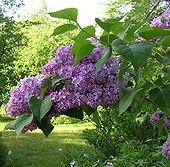
Wisteria
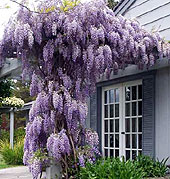
Oriental Poppy

|
Conclusion
That's it! It really doesn't get any easier than this if you want to
propagate trees, shrubs and many perennials.
Now is the best time, so if you have some favorite plants that you
would like more of, this is a fast, and economical way to do it.
Plus, if you have friends or neighbors that have plants you would like
to have, they probably wouldn't mind your taking a few cuttings, so
this is also a great way to add to your own garden.
Or - if they're up for it, swap some root cuttings from your yard in
exchange for some root cuttings from your friends, family or neighbor's
yards. You can really add quickly to your garden that way, and again,
it costs nothing except a little bit of your time.
|
 |
Hilary Rinaldi is a member of the National Garden Writers Association, a nationally published writer, and
a certified organic grower. She regularly speaks and writes about all
gardening related topics, with an emphasis on making gardening a
successful and enjoyable process for anyone who wants to learn. Weekend
Gardener Monthly Web Magazine concentrates of giving detailed gardening
tips and gardening advice to all levels of gardeners.
Back to
Propagation
by Cuttings Page
|
Copyright WM Media. All rights reserved.
This work is licensed under a Creative Commons Attribution-NoDerivs 2.5 License.
|















